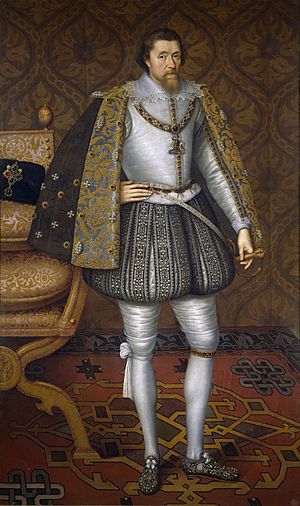Oath of Allegiance of James I of England facts for kids
The Oath of Allegiance was a special promise that people in England had to make in 1606. It was created by King James I after a big event called the Gunpowder Plot in 1605. This oath made English Catholics promise their loyalty to King James I instead of the Pope. It became law on June 22, 1606, and was also known as the Oath of Obedience. This new law caused a lot of arguments and discussions for many years, not just in England but around the world.
What the Oath Said
The Oath of Allegiance became an official law on June 22, 1606. It had seven main points that people had to agree to. It was designed to challenge certain political ideas at the time.
Part of the oath said:
- "I, A.B., truly promise and declare that King James is the rightful King of this country."
- "I also promise that the Pope, or anyone from the Church of Rome, does not have the power to remove the King from his throne."
- "The Pope cannot allow any foreign prince to attack the King or his lands."
- "The Pope cannot tell the King's subjects to stop being loyal to him."
- "I swear that even if the Pope excommunicates the King (kicks him out of the Church), I will still be loyal and faithful to His Majesty."
- "I strongly disagree with the idea that kings who are excommunicated by the Pope can be removed or killed by their subjects."
- "I believe the Pope cannot free me from this oath."
This oath was very important because it directly challenged the Pope's power over kings and their subjects.
How Catholics Reacted
The new Oath of Allegiance caused a lot of disagreement among English Catholics. They wondered if they could honestly take the oath and still follow their faith. After the Gunpowder Plot, the leader of the English Catholic priests, George Blackwell, asked the Pope for guidance. Pope Paul V wrote a letter condemning the plot and telling Catholics to keep the peace.
Blackwell first thought the oath was wrong. But then, he told his priests that they could take the oath, believing it was about civil obedience. However, the Pope soon officially said the new oath was forbidden.
Blackwell was arrested in June 1607. He was questioned about the oath for ten days. In the end, he took the oath, trusting King James's promise that it wouldn't interfere with their religious beliefs. He even told other Catholics to do the same. But the Pope then issued another official statement in August 1607, again forbidding the oath.
A well-known Catholic scholar, Bellarmine, wrote to Blackwell, criticizing him for taking the oath against the Pope's wishes. Blackwell's actions didn't please the Pope, who replaced him with George Birkhead in February 1608. The English government also wasn't happy and put Blackwell in prison.
Another priest, William Bishop, had previously shown loyalty to Queen Elizabeth. He was against the Jesuits, a Catholic religious order. However, he refused to take the Oath of Allegiance. He agreed that the Pope shouldn't have the power to remove kings, but he didn't want to take the oath because he wanted to protect the reputation of other Catholic priests in Rome.
Later Years of the Oath
The main arguments about the Oath of Allegiance happened between 1608 and 1614. However, books and papers discussing it continued to appear until 1620. Even after that, it remained a topic of debate.
The oath was used against Catholics throughout the rest of the 17th century. Many Catholic priests and individuals, like Robert Drury and Edmund Arrowsmith, faced challenges because of it. Some even wrote against it.
George Calvert, 1st Baron Baltimore, who was Catholic, tried to settle in Virginia in America. But the oath had been introduced there in 1609, and it stopped his plans. His son, Cecilius Calvert, 2nd Baron Baltimore, later told his own settlers to take the oath, though it's not clear if he always made them.
King Charles I, James I's son, generally understood that Catholics couldn't take the Oath of Supremacy (another oath). He often helped them avoid it. However, he believed in the "divine right of kings" (that kings get their power from God), so he liked the Oath of Allegiance. He was annoyed when Catholics refused it or argued against it.
It is said that Pope Urban VIII condemned the oath again in 1626, and the arguments continued. Some people still wrote in defense of the oath, even at King Charles's request. But their main opponent was a Jesuit priest named Edward Courtney, whom Charles then imprisoned.
In 1681, a famous university in Paris, the Sorbonne, looked at the English oath. They found very little to disagree with in it, which was a significant statement at the time.
Images for kids



